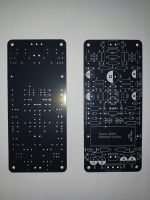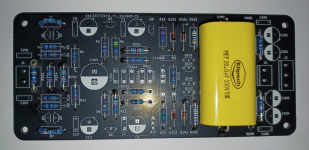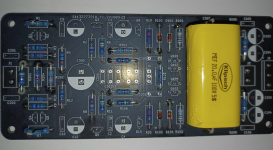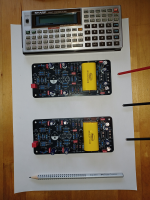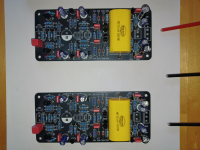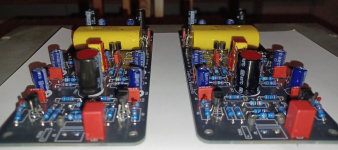The lean bass may be due to insufficient open-loop gain. I estimate the open-loop gain is in the low 70s dB, which would lead to a RIAA EQ error at low frequencies.
Ed
Ed
How high?
Ed
The lean bass may be due to insufficient open-loop gain. I estimate the open-loop gain is in the low 70s dB, which would lead to a RIAA EQ error at low frequencies.
Ed
Too little OLG in the low bass range?
Definitely a clear NO at this point. As I always do my homework and know RIAA EQs inside out, I think that +100dB could be enough, don't you?
HBt.
As soon as Morten's circuit boards arrive, I'll get to work - and get to the bottom of everything. I will probably start by looking at the "RUBY" circuit. Because SUPRA itself works perfectly. How do I know that? Of course I have the current dimensioning in my back as a test circuit on a breadboard. I don't operate in a vacuum.I subjectively feel it reproduces less and firmer bass than the OREAD. I haven't done any a/b testing, it's just from memory.
Note:
This board must be optimally shielded from all external and internal fields.
hbt.audio
Okay, my small-signal calculation matches the open-loop gains for the loadings you have used.Too little OLG in the low bass range?
Definitely a clear NO at this point. As I always do my homework and know RIAA EQs inside out, I think that +100dB could be enough, don't you?
I had assumed the loading of core-outp would be closer to 30K.
Ed
Last edited:
Okay, my small-signal calculation matches the open-loop gains for the loadings you have used.
I had assumed the loading of core-outp would be closer to 30K.
Ed
CLG without EQ
Rload ---> 5k12
riq(dc to 50Hz) ---> less 5300Ohm !
If the input resistance of the RUBY buffer is only 53kOhm, then the error at 20Hz is -1dB. However, when loaded with 500kOhm, the maximum error at 20Hz is only -0.1dB. So if the deepest bass on a long-playing record fades, it is due to the input resistance of the incredibly interesting buffer in the form of the diamond. The most extreme would be -1dB at 20Hz. I have already discussed this fact.
@alugner
Use at least 470µF charging capacity. If the two capacitors are only 47µF, then the reason for the somewhat thin low bass impression has already been identified. This capacitor is more or less a battery and, the larger the series resistors are, in our case it's 75 Ohm, it must be up to 1000µF. Otherwise the bass will fade.
see also my posting #26
kindly,
HBt.

Last edited:
Boards on its way! 🙂Ruby III
View attachment 1405700
r_input = 900kOhm
there is also no problemo 🙂
@m0rten,
thank you very much in advance from my side, let's see how long the mail ship will be on its way.
hbt.audio
@EdGr
Remember that we need a current-to-voltage converter - and that is the RIAA network, (or even) our frequency-dependent negative feedback resistor. Just like in the OREAD-EQ, this trick (the current injection) is what makes it special. It may be old hat, but who can still distinguish these subtleties today?
regards,
HBt.
Remember that we need a current-to-voltage converter - and that is the RIAA network, (or even) our frequency-dependent negative feedback resistor. Just like in the OREAD-EQ, this trick (the current injection) is what makes it special. It may be old hat, but who can still distinguish these subtleties today?
regards,
HBt.
The logical conclusion is to forget about negative feedback and use a transconductance amplifier to drive a passive EQ network. I do that in my Top Secret pre-amp. 😉hbtaudio said:Remember that we need a current-to-voltage converter - and that is the RIAA network, (or even) our frequency-dependent negative feedback resistor.
Ed
Should I reveal the secret Ed 😉.I do that in my Top Secret pre-amp. 😉
Ed
It's quite clear that other mothers also have beautiful daughters. The important thing is that we keep the tradition alive and can enjoy our record collections as much as possible - as I write this, my turntable is spinning the black disk. Well, and that we show our youngsters what quality is.

Dear Morten,
I received the circuit boards today. Many thanks for your efforts and the fantastic quality.
I'll get to work in the next few days and report here on the progress, measurements and listening impressions ...
Greetings from Lower Saxony,
HBt.
🙂
I received the circuit boards today. Many thanks for your efforts and the fantastic quality.
I'll get to work in the next few days and report here on the progress, measurements and listening impressions ...
Greetings from Lower Saxony,
HBt.
🙂
Attachments
Not a beginner's project
With this version of the circuit board, the most careful working method is a must. 0.5mm silver solder with 3.5% flux as well as an internally heated and, above all, suitable soldering tip is required. White print on a black background requires good daylight lighting - a healthy eye and no trembling hands, a night of drinking is out of the question. The soldering islands are minimal in area, the capillary effect of the through-hole plating does not always work perfectly ...
But after almost 14 hours of work and extreme concentration - you have to be able to concentrate for several hours - both boards are perfectly assembled and soldered.
Please do not forget to select the transistors used, at least the HFE of each individual BJT must be determined, all paired and preferably the same (they should also be the same, more on this topic later).
#
Check all your solder joints with a magnifying glass or under a microscope if the normal visual inspection leaves you in doubt. This can only be remedied with a larger island diameter.
Always check all components first.
##
Now comes the first static test, connect a current-limited voltage source - and measure all potentials and selected voltage drops.
check
Everything is fine with me - and now I'm looking for tiny 3.3nF and equally tiny 10nF FKPs, unfortunately WIMA FKPs are too wide for the nice PCB layout, the narrow version has to be used ... search, measure and select!
greetings,
HBt.
By the way
only pre-aged 100V film types are suitable as output coupling capacitors in the HihgEnd noble version. It is best to desolder a suitable pair from an old loudspeaker crossover. Used; this coupling capacitor and real current flow has already shown what it can do.
😉
Supra24 Core
and
Ruby3
dc-offset are 0V
with
Vcc +/- 9.7Vdc
!
With this version of the circuit board, the most careful working method is a must. 0.5mm silver solder with 3.5% flux as well as an internally heated and, above all, suitable soldering tip is required. White print on a black background requires good daylight lighting - a healthy eye and no trembling hands, a night of drinking is out of the question. The soldering islands are minimal in area, the capillary effect of the through-hole plating does not always work perfectly ...
But after almost 14 hours of work and extreme concentration - you have to be able to concentrate for several hours - both boards are perfectly assembled and soldered.
Please do not forget to select the transistors used, at least the HFE of each individual BJT must be determined, all paired and preferably the same (they should also be the same, more on this topic later).
#
Check all your solder joints with a magnifying glass or under a microscope if the normal visual inspection leaves you in doubt. This can only be remedied with a larger island diameter.
Always check all components first.
##
Now comes the first static test, connect a current-limited voltage source - and measure all potentials and selected voltage drops.
check
Everything is fine with me - and now I'm looking for tiny 3.3nF and equally tiny 10nF FKPs, unfortunately WIMA FKPs are too wide for the nice PCB layout, the narrow version has to be used ... search, measure and select!
greetings,
HBt.
By the way
only pre-aged 100V film types are suitable as output coupling capacitors in the HihgEnd noble version. It is best to desolder a suitable pair from an old loudspeaker crossover. Used; this coupling capacitor and real current flow has already shown what it can do.
😉
Supra24 Core
and
Ruby3
dc-offset are 0V
with
Vcc +/- 9.7Vdc
!
Attachments
Addendum:
- R202 must be 150kOhm, as must R302
- R204 is now 68kOhm so that our input impedance forms the required 47k MM termination
- I have soldered in an MKS 1µF 100V type from WIMA as the input coupling capacitor. I set R201 to 4.7 ohms (10 will do, but 100 is too big for my taste) and two ferite beads
- R101 and R102 can also be 110Ohm in combination with 1N4448 there is a constant current round about 4mAdc
- R107 -> 75Ohm & R203 -> 1MOhm
- R1 = R7 -> 6k96
- The core is only balanced if you select and pair meticulously and adhere to the resistance values from posting #1
- C103 = C104 -> 1000µF /16Vdc
- C204 = C205 -> 47µF /35Vdc
The 100% correct time constants result from the capacitance values 6.767nF and 19.58nF (as well as 12kOhm & 150kOhm), i.e. we can precisely measure a 6.8nF-FKP2.5%, as well as precisely measure and solder in a tower of four stacked 4.7nF-FKP5%. I have used 6.79nF & 19.615nF on both boards.
I used the Voltcraft LCR-400, which is clunky but much smaller and more portable than a large measuring bridge (as a table-top or built-in device). The exact resistance ratio of the RIAA network no. 2 (my way of counting the known four topologies) is 12.4034, the capacitance ratio is 2.9158.
#
The total deviation from the equalization curve should now automatically remain within the limits of +/-0.15dB. I assume that the approximation will be significantly better - I will measure it at some point. But now the fantastic power supply board from @catd comes into play, a real universal genius.
I'm already excited:
Can this idiosyncratic high-end design, as you can see from the huge yellow output coupling capacitor (which is really not needed at 0Vdc output offset), steal the thunder from OREAD?
😉
I used the Voltcraft LCR-400, which is clunky but much smaller and more portable than a large measuring bridge (as a table-top or built-in device). The exact resistance ratio of the RIAA network no. 2 (my way of counting the known four topologies) is 12.4034, the capacitance ratio is 2.9158.
#
The total deviation from the equalization curve should now automatically remain within the limits of +/-0.15dB. I assume that the approximation will be significantly better - I will measure it at some point. But now the fantastic power supply board from @catd comes into play, a real universal genius.
I'm already excited:
Can this idiosyncratic high-end design, as you can see from the huge yellow output coupling capacitor (which is really not needed at 0Vdc output offset), steal the thunder from OREAD?
😉
Attachments
I have to admit I was more careful when selecting the riaa related components based on actual measured value when I assembled OREAD 🙄
This is also a rather tedious undertaking, with the 1% Siemens Styroflex (which of course has not been on the market for a miserably long time) - which were definitely used in the original Elektor Supra, you could save yourself any measuring and assembling. It's really annoying, but also absolutely necessary - it's best to buy a bag of MKS from time to time, number them, measure and document. Now you can quickly look at the list later and select the appropriate values - parallel connections are usually extremely practical, but series connections are also possible. My supplies are now exhausted.
Not a single MKP4 buzzer would have fitted, but that doesn't matter - stacking is a real botch - if you are prepared. Another confusing hint: the capacitance value is not constant over the frequency ..!
#
My gut feeling tells me: it will be really hard to beat the OREAD-EQ.
If "Supra24 with Ruby3" can achieve this, then this EQ will easily beat the Greek and American competition (of this forum) - purely subjectively, of course.
##
I can already see the tomatoes flying as we sit in the salad.

- Home
- Source & Line
- Analogue Source
- MM-EQ; the SUPRA2024
